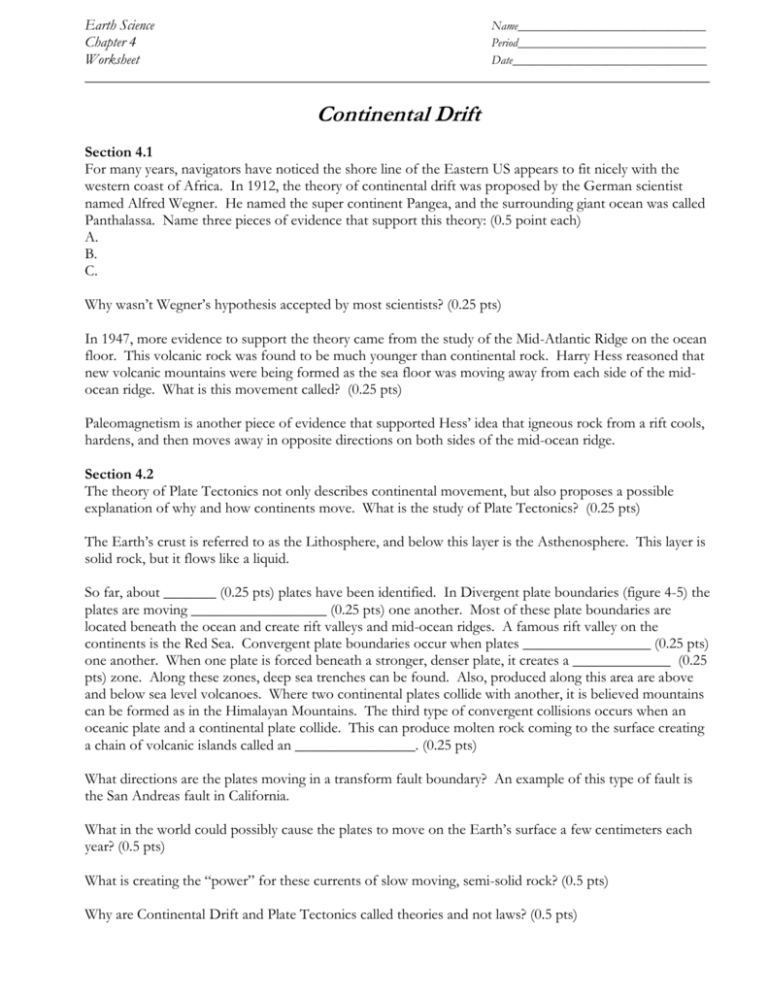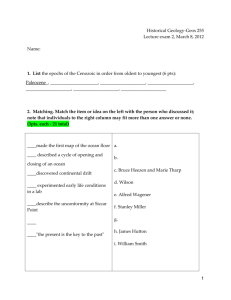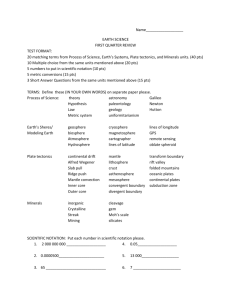Quiz Maker - Geneva 304
advertisement

Earth Science Name______________________________ Chapter 4 Period______________________________ Worksheet Date_______________________________ ___________________________________________________________________________________ Continental Drift Section 4.1 For many years, navigators have noticed the shore line of the Eastern US appears to fit nicely with the western coast of Africa. In 1912, the theory of continental drift was proposed by the German scientist named Alfred Wegner. He named the super continent Pangea, and the surrounding giant ocean was called Panthalassa. Name three pieces of evidence that support this theory: (0.5 point each) A. B. C. Why wasn’t Wegner’s hypothesis accepted by most scientists? (0.25 pts) In 1947, more evidence to support the theory came from the study of the Mid-Atlantic Ridge on the ocean floor. This volcanic rock was found to be much younger than continental rock. Harry Hess reasoned that new volcanic mountains were being formed as the sea floor was moving away from each side of the midocean ridge. What is this movement called? (0.25 pts) Paleomagnetism is another piece of evidence that supported Hess’ idea that igneous rock from a rift cools, hardens, and then moves away in opposite directions on both sides of the mid-ocean ridge. Section 4.2 The theory of Plate Tectonics not only describes continental movement, but also proposes a possible explanation of why and how continents move. What is the study of Plate Tectonics? (0.25 pts) The Earth’s crust is referred to as the Lithosphere, and below this layer is the Asthenosphere. This layer is solid rock, but it flows like a liquid. So far, about _______ (0.25 pts) plates have been identified. In Divergent plate boundaries (figure 4-5) the plates are moving __________________ (0.25 pts) one another. Most of these plate boundaries are located beneath the ocean and create rift valleys and mid-ocean ridges. A famous rift valley on the continents is the Red Sea. Convergent plate boundaries occur when plates _________________ (0.25 pts) one another. When one plate is forced beneath a stronger, denser plate, it creates a _____________ (0.25 pts) zone. Along these zones, deep sea trenches can be found. Also, produced along this area are above and below sea level volcanoes. Where two continental plates collide with another, it is believed mountains can be formed as in the Himalayan Mountains. The third type of convergent collisions occurs when an oceanic plate and a continental plate collide. This can produce molten rock coming to the surface creating a chain of volcanic islands called an ________________. (0.25 pts) What directions are the plates moving in a transform fault boundary? An example of this type of fault is the San Andreas fault in California. What in the world could possibly cause the plates to move on the Earth’s surface a few centimeters each year? (0.5 pts) What is creating the “power” for these currents of slow moving, semi-solid rock? (0.5 pts) Why are Continental Drift and Plate Tectonics called theories and not laws? (0.5 pts)








